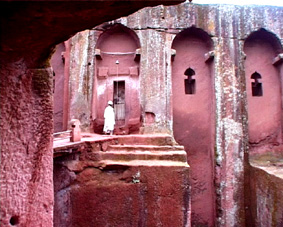Pegasos Tours Back to: Mysteries | Main Page | The Legend | History | Location | 5
The
11
rock hewn Churches in ![]()
 |
Visit also the: First Group or Second Group with many photos and a detailed description for each Church!
The very first person to visit Lalibela was Francisco Alvarez, a monk from Portugal. He arrived around the year 1521 and made an accurate account of the Holy site. |
| The Magnificent facade of Saint Gabriel Church | * You can click on any picture to see details ! |
| Most Churches in Lalibela are rock-hewn monolithic (out of one stone) which imitate a build up structure but are cut in one piece from the rock and separate from it all round by a deep trench. You cannot find structures like these any where else in the world .The construction of a monolithic Church was actually an excavation. The method of which this work was carried out can be easily guessed: |
 |
| * You can click on any picture to see details ! | Saint George, the most impressive Church in Lalibela |
 |
The workers cut free a square or a rectangular piece of rock by excavating a trench all round it. Later the skilled masons chiseled out the church, at first start shaping the exterior and gradually proceeding to the interior from the top row of windows and last carving the fine details such as columns, pillars beams and arches. When you admire the finished work you may think of all the organizing, logistics, human resources, tools used and all that at the year 1125 ! |
| Saint George, top view at Timkat celebrations | * You can click on any picture to see details ! |
| There are many technical details to prove the high standards of technical knowledge the architects and builders must have had: In each group the Churches are build on several levels so that at the time of the high rainfall (July) the water is carried out successfully through the trenches which serve as drainage system. Also the placing of all Churches conforms with to the slope of the terrain and the roofs, gutters and plinth are slanted equally. |
 |
| The magnificent Saint Emmanuel facade | |

Bet Mercurios |
Several legends are connected with Saint Mercurios which he
stands for the Christian faith while emperor Julian for Roman empire.
Saint Mercurios as a martyr professed his faith to Julian and was
condemned to to be beheaded!
The part serving today as a Church occupies the Eastern end of the once huge subterranean hall which nowadays opens in a court yard. * click on any picture to see more photos & details |
| One of the important foreign model for the Ethiopian rock
Churches is the Basilica style which originated from Greece and
represents a big assembly hall with flat ceiling a nave and two or
more aisles. An other important factor in the layout of the Basilica
Church is that it should be oriented with the Holy of holies to the
east and the narthex, the main entrance hall to the west.
According to an old Ethiopian tradition, every Church must have a ‘Tabot’ on the Altar. The ‘Tabot’ is a slab of stone or wood representing the tables of law which Moses originally placed inside the famous Arc. All ‘Tabots’ are decorated with engravings and paintings of the Saint which the Church is dedicated to. |
 Aerial view of
Saint Mary group of
Churches
Aerial view of
Saint Mary group of
Churches
|